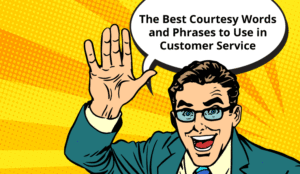If you are looking to improve the customer experience, courtesy calls (sometimes misspelt as curtesy calls) can provide you with an opportunity to nurture relationships, show appreciation, and provide exceptional customer service.
In this article, we define courtesy calls, exploring the ins and outs of courtesy calling – including their purpose, timing, benefits, and potential pitfalls.
What is a Courtesy Call?
A courtesy call, as defined by the Cambridge Dictionary, is “a visit or phone call that a company makes to customers, for example, to thank them for their business or ask if they are satisfied with the company’s service.”
Courtesy calling refers to businesses proactively reaching out to customers to express gratitude, offer assistance, or simply maintain a relationship. These calls are not focused on selling but on fostering positive, ongoing connections.
An Example of a Courtesy Call
“Hello, Mrs. Smith. I’m just calling today to find out how you are getting on with your new boiler and if I can answer any questions for you?”
How Can Courtesy Calling Enhance CX?
Courtesy calling is a way to enhance customer experience (CX) by adding a personal touch to interactions, and typically occur after a purchase as a post-sale follow-up to ensure the customer is happy with their product or service.
This proactive approach allows businesses to address any potential concerns early, which not only improves the overall experience but also builds trust and strengthens the relationship.
Beyond post-sale follow-ups, courtesy calls can be integrated throughout the customer journey to nurture ongoing relationships.
By reaching out at different stages – such as before a service starts or during a long-term contract – businesses show that they care about the customer beyond the initial transaction.
This continuous engagement fosters long-term loyalty and makes customers feel valued, which can lead to higher retention and satisfaction.
Courtesy calls also offer personalized communication that can be tailored to the customer’s needs, and by offering customers the choice of how they prefer to communicate, businesses can further enhance the experience, making it more convenient and customer-focused.
Who Makes Courtesy Calls?
Courtesy calls are typically made by individuals within customer service or contact centre departments.
Job titles may vary, but common positions responsible for conducting courtesy calls include:
- Customer service representatives (also known as ‘agents’ and ‘advisors’)
- Account managers
- Client relationship managers
Why Do Businesses Make Courtesy Calls?
Businesses engage in courtesy calls for 4 key reasons, including to:
1. Follow Up With New Customers
A courtesy call after a customer has purchased a product is an excellent way to check that the customer is happy with their purchase and shows that you value their custom.
This follow-up allows you to check in with the customer, address any concerns they may have, and confirm that the product meets their expectations.
By proactively reaching out, you not only show that you value their business but also create an opportunity for building a stronger relationship with them.
2. Address Concerns
Courtesy calls provide an opportunity to address any concerns or issues the customer may have experienced since their purchase.
By reaching out, businesses show that they genuinely value customer feedback and are dedicated to resolving any potential problems.
When customers feel heard and their concerns are addressed promptly, it installs a deeper sense of trust and loyalty towards the brand.
Ultimately, these calls can transform a negative experience into a positive one, demonstrating that the business is genuinely invested in the satisfaction and well-being of its customers.
3. Upsell
Courtesy calls can also be an effective toll for upselling or cross-selling additional products or services that complement the customer’s original purchase.
This approach not only increases revenue but also strengthens the customer relationship by demonstrating a keen understanding of their preferences and requirements.
When customers perceive that the recommendations genuinely align with their interests, they are more likely to consider these additional offerings.
4. Share Progress on an Existing Issue
Courtesy calls provide an excellent opportunity to update customers on the status of any ongoing issues they may have reported.
For example, a call can serve to remind the customer that an engineer will be arriving at 2 o’clock today to fix the problem they recently reported.
This proactive communication not only reassures the customer that their concerns are being addressed but also demonstrates your commitment to timely service.
By keeping customers informed, you help to manage their expectations and reduce any anxiety they may have about the situation.
What Are the Benefits of Making Courtesy Calls?
Courtesy calls offer several benefits for both businesses and customers, including to:
Enhance Customer Loyalty
Making courtesy calls plays a crucial role in developing stronger customer relationships, which is essential for enhancing customer loyalty.
By taking the time to check in with customers, businesses show that they value their patronage and care about their satisfaction.
This personal touch not only makes customers feel appreciated but also encourages them to return for future purchases. As loyalty grows, customers are more likely to recommend the business to others, further expanding its reach and influence.
For more great ideas on winning customer loyalty, read our article: 7 Key Ideas for Winning Customer Loyalty
Gather Feedback
These calls provide a valuable opportunity for businesses to actively engage with customers and collect insightful feedback about their experiences.
By initiating these conversations, companies can quickly identify any issues or concerns, allowing them to address problems promptly before they escalate.
This direct line of communication not only helps to resolve customer grievances but also demonstrates that the business values their opinions and is committed to improvement.
Additionally, the feedback gathered can inform product enhancements or service adjustments, ensuring that offerings align with customer needs and preferences.
Seek Assistance
Courtesy calls offer customers a valuable platform to voice their opinions and seek assistance regarding their experiences with a product or service.
During these calls, customers can share any challenges they may be facing, ask questions, or request additional support, making them feel heard and valued.
This open communication develops a sense of connection between the customer and the business, enhancing their overall experience.
What Are Some of the Pitfalls of Courtesy Calls?
While courtesy calls can be an effective relationship-building tool, there are potential pitfalls to be aware of, including:
The Challenge of Timing
One of the main pitfalls of courtesy calls is the challenge of timing, as calls that are too frequent or poorly timed can easily be come across as intrusive or pushy.
For instance, contacting customers shortly after a purchase might feel overwhelming, while reaching out during inconvenient hours can disrupt their day.
When customers feel bombarded by calls, it can lead to frustration and annoyance, ultimately damaging the relationship between the customer and the business.
Poor Training
Another pitfall of courtesy calls is the potential for poor training among representatives, which can severely impact the quality of the customer interaction.
If agents are not adequately prepared or lack understanding of the products and services, they may struggle to address customer concerns or answer questions effectively.
This can lead to frustration on both sides, as customers leave the conversation feeling unheard and unsatisfied.
Too Salesy
A common pitfall of courtesy calls is the risk of customers perceiving them as overly sales-oriented, which can undermine the intended purpose of the interaction.
When representatives focus too much on promoting additional products or services rather than genuinely checking in on customer satisfaction, it can come across as insincere and transactional.
This approach can frustrate customers, making them feel that their concerns are secondary to sales goals, which diminishes the trust and rapport that courtesy calls aim to build.
As a result, customers may become resistant to future interactions, viewing them as mere attempts to upsell rather than authentic conversations.
What to Cover in Your Next Courtesy Call
Each call presents an opportunity to strengthen the customer relationship, demonstrate excellent customer service, and foster loyalty towards your business – drawing on the essential rules of phone etiquette.
When making a courtesy call, it is therefore important to have a clear understanding of what to include in the conversation.
By structuring the call effectively and addressing key points, businesses can maximize the impact of these interactions and leave a positive impression on their customers.
Here are some essential elements to include in a courtesy call:
Greeting and Introduction
Start your courtesy call by warmly greeting the customer and introducing yourself to create a welcoming atmosphere.
Using a friendly and professional tone right from the start helps establish a positive rapport and sets the stage for a productive conversation.
To provide context, briefly remind the customer about your previous interaction or any relevant details that connect you to them, which reinforces that you remember their unique situation.
Examples:
- “Hello, [Customer’s Name]! This is [Your Name] from [Your Company]. I hope you’re doing well today. I wanted to follow up on your recent purchase and see how everything is going with it.”
- “Hi, [Customer’s Name]! This is [Your Name], and I’m reaching out from [Your Company]. It was great speaking with you last week, and I wanted to check in to ensure you’re satisfied with your new product.”
For more information on customer service greetings, read our article: The Best Customer Service Greeting Phrases – With Examples
Express Gratitude
Show appreciation for the customer’s business and express gratitude for their support. Let them know that you value their relationship and that their satisfaction is important to you. Acknowledge their loyalty and the trust they have placed in your business.
This simple yet impactful gesture can leave a lasting impression, making customers feel recognized and valued.
Examples:
- “I want to take a moment to thank you for being a valued customer, [Customer’s Name]. Your support means a lot to us, and we genuinely appreciate the trust you place in our company.”
- “I really appreciate your business, [Customer’s Name]. Thank you for your continued loyalty; it’s customers like you who inspire us to strive for excellence every day.”
Purpose of the Call
It’s essential to clearly state the purpose of the courtesy call. It could be to follow up on a recent purchase, enquire about their satisfaction with a product or service, offer assistance or support, or simply to check in and see how they are doing.
Be transparent about why you are reaching out and emphasize that your intention is to ensure their needs are met.
Examples:
- “The reason I’m calling today is to follow up on your recent purchase and see how you’re finding the product. Your satisfaction is is our priority, and I want to ensure everything is working well for you.”
- “I’m reaching out to follow up on your recent experience with our customer support team. I’d like to ensure that any issues have been resolved and see if there’s anything else we can do for you.”
Active Listening
During the call, actively listen to the customer’s responses, concerns, or feedback. Give them ample opportunity to express their thoughts and feelings.
Take notes if necessary to ensure you capture all the relevant information. This demonstrates that their opinions are valued and that you are committed to meeting their needs.
Looking to train your agents on active listening? Read our article: How to Train Active Listening in the Call Centre – With Four Exercises
Problem Resolution
When customers raise any issues or concerns during your courtesy call, it’s crucial to respond with empathy and understanding.
Actively work towards finding a solution as quickly as possible by offering alternatives, providing relevant information, or escalating the matter to the appropriate department if necessary.
Your goal should be to leave the customer feeling heard, respected, and confident that their concerns are being addressed promptly.
By effectively resolving issues, you not only enhance customer satisfaction but also strengthen the trust they have in your business.
Examples:
- “Thank you for sharing your concerns with me. I completely understand how frustrating this must be for you, and I’m here to help. I can provide you with some options to address the issue, or if you prefer, I can escalate this to our support team to ensure it gets resolved as soon as possible.”
- “Thank you for bringing this concern to my attention. I can imagine how frustrating this situation must be, and I want to make it right. Let’s explore a few solutions together, and if needed, I can reach out to the relevant department to ensure we get this resolved promptly.”
Upselling or Cross-Selling Opportunities
During your courtesy call, there may be appropriate moments to explore upselling or cross-selling opportunities that could enhance the customer’s experience.
If relevant, you can mention any new products, upgrades, or complementary services that align with their needs or previous purchases, providing them with valuable options to consider.
However, it’s crucial to approach this conversation with care; you want to ensure that the customer feels supported rather than pressured.
By framing these suggestions as enhancements to their current experience, you can keep the focus on their satisfaction and needs.
Examples:
-
“By the way, since you’re enjoying our current service, I wanted to mention that we recently launched a new feature that many of our customers have found very helpful. Would you like me to share a bit more about how it could enhance your experience?”
- “I noticed that you’ve been using our product for a while, and there’s a newer model available that offers some great additional features. If you’re interested, I can provide more information so you can see if it might be a good fit for your needs.”
Closing and Next Steps
Before concluding the courtesy call, summarize the key points discussed to ensure both you and the customer are on the same page.
Confirm any actions that will be taken, such as resolving an issue or sending additional information, to reinforce accountability.
Make sure to thank the customer once again for their time and engagement, emphasizing that their satisfaction is your priority.
This final touch not only leaves a positive impression but also strengthens the relationship, encouraging future interactions.
Examples:
- “To recap our conversation, we discussed the issue with your order, and I will ensure that a replacement is sent out by tomorrow. I’d like to schedule a follow-up call for next week to check on your satisfaction with the new product. Thank you so much for your time today.”
- “Just to summarize, we’ve addressed your concerns about the service delay, and I will escalate this to our management team for quicker resolution. I’ll follow up with you in two days to provide an update. Thank you for taking the time to speak with me today.”
Documentation and Follow-Up
After the call, make sure to document the details of the conversation, including any action items or commitments made.
This information will be valuable for future reference and will help maintain consistency in customer interactions.
If applicable, follow up with the customer via email or another preferred communication channel to provide additional information or confirm the resolution of any issues.
By incorporating these elements into your courtesy calls, you can ensure that the conversation is purposeful, engaging, and focused on meeting the customer’s needs.
When to Avoid Using Courtesy Calls
While courtesy calls can be a valuable tool in building customer relationships, it is important to recognize situations where they may not be appropriate or preferred.
It is important to recognize when alternative methods may be more suitable or when courtesy calls may not align with the customer’s preferences, so businesses can tailor communication strategies for optimal results and customer satisfaction.
Here are some instances when it may be best to avoid using courtesy calls:
1. Unsolicited Calls
Making courtesy calls to customers who have not explicitly expressed interest or consented to receiving such calls can be perceived as intrusive or unwelcome.
It is crucial to respect privacy preferences and adhere to applicable laws and regulations, such as “do not call” lists, to avoid upsetting customers.
2. Time-Sensitive Matters
Courtesy calls may not be the most efficient method of communication when dealing with urgent issues.
In situations where immediate action is required, it may be more appropriate for an account manager to handle the matter separately – instead of waiting for the affected customer to reach the top of the dialling queue in due course.
3. Customers’ Preferred Communication Channels
Some customers may have specific preferences for communication channels and may not appreciate receiving courtesy calls.
It is essential to respect their choices and use the channels they have indicated as their preferred means of contact. This could include email, live chat, or self-service portals.
4. Repeat Calls Before an Issue Is Properly Resolved
If a customer has already reached out to your business with an issue or concern, and the matter is still unresolved, repeated courtesy calls without progress or updates may frustrate the customer.
In such cases, it is advisable to focus on actively resolving the issue rather than repeatedly checking in without tangible results.
5. Negative Customer Feedback
If a customer has expressed dissatisfaction or provided negative feedback about their experience with your business, a courtesy call may not be the most appropriate first response.
In such cases, it is advisable to address the feedback through a different channel, such as email or a formal complaint resolution process, to ensure the customer feels heard and to allow for a more thoughtful and measured response.
By following this guidance, you can ensure that every courtesy call serves to actively build and maintain positive relationships and ultimately enhance the customer experience (CX).
For more tips on how to build rapport in the contact centre, check out these articles:
- Best Tips, Phrases and Words to Use for Building Rapport
- The Best Courtesy Words and Expressions to Use in Customer Service
- How to Build Rapport on the Phone – With Examples
Author: Megan Jones
Reviewed by: Hannah Swankie
Published On: 26th Jul 2023 - Last modified: 21st Oct 2024
Read more about - Customer Service Strategy, CX








































